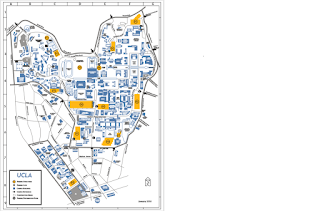Event 3
Through the DESMA 9 class, I learned a lot about the relationship between science, technology, and art, and how it applies to one another. Moreover, I also learned how the artists applied science and technology to their works and studied what new art worlds appeared. However, I have only seen new arts indirectly through this class, but I have never actually encountered such the works of art. Therefore, I decided to write the third essay on the event with the purpose of exhibiting the works of the new art world. I found the event, named “HYPNAGOGIA” that had a plan to open from 5 to 7 at the Art | Sci Center Gallery, 5th Floor, in the events list sent by the professor Vesna (HYPNAGOGIA).
As soon as I entered the event on time, there were several things that looked like white balls hanging from the ceiling. In addition, a computer was located in the middle of the room, and a video of a girl talking about something was played on one side of the room. On other sides, there were writings about something. To understand this event, I tried to read the articles on the walls and books that described the story of a person from the past to the present, not just for a few days.
When I asked about the book to CHELLY, she said that the book was written in detail about her nightmares and dreams for six years. She thinks that dreaming provides insight into the thoughts and impulses that are deep in people's minds. She said that the patterns and symbols that appear in that dream are eventually the cause of the true fear of trauma or the love for others. furthermore, she also explains to us that subconscious is not the only aspect of being, and conscious mind has its own behavioral fluidity, which means that people's thoughts are created through the proper relationship between consciousness and subconscious.
As Frazzetto and Anker said "Ideas, concepts, and images in neuroscience widely circulate in culture and are portrayed in literature, film, works of art, the mass media and commercial products " (Frazzetto and Anker), neuroscience has been applied to a variety of fields, which leads to the appearance of new art world called "Neurasthenics". I thought her work belongs to Neurasthenics. EEG, which is the neuron communication within the brain of people from the roots of all the thoughts, emotions and actions of people, is produced by synchronized electric pulses in the mass of neurons that communicate with each other (BR
AINWORKS). CHELLY applied the theory to her works by using EEG brainwave sensor that captures objective measurements of the brainwave process and converts this data into a coordinated light sequence (Wearable sensing). This method has allowed her to express her subconscious as the art by providing her with the data on subjective dreams. Through people’s concern for the brain, the scientists and artists are able to have new perspectives and increased creativity that transcends cultural boundaries, as Jung said “the fascination of the psyche brings about a new self-appraisal, a reassessment of our fundamental human nature” (Jung) Her works, which was created by collaborating between art and neuroscience, was a harmonious interaction between these mind-states and was very impressive to me.
Reference
Electroencephalography (EEG)”, Wearable
sensing, Accessed on June 2, 2018
<http://wearablesensing.com/technology_eeg.php>
“WHAT ARE BRAINWAVES?”, BRAINWORKS, Accessed
on June 2, 2018
<https://brainworksneurotherapy.com/what-are-brainwaves>
“HYPNAGOGIA”, ARTSCI UCLA, Accessed on June
2, 2018
<http://artsci.ucla.edu/node/1392>
Jung, Carl Gustav. The Spiritual Problem of
Modern Man. Mayavati: n.p., 1931. Print. Accessed on June 2, 2018
.
Frazzetto, Giovanni, and Suzanne Anker.
"Neuroculture." Nature Reviews Science and Society: Neuroculture 10
(2009): 815-21. Print. Accessed on June 2, 2018.





댓글
댓글 쓰기